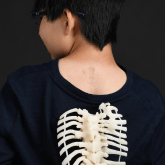Congenital Scoliosis
Surgical options for congenital scoliosis are considered when the curvature of the spine is severe, progressive, or associated with other health issues. The goal of surgery is to correct the spinal deformity, prevent further progression, and maintain a stable and balanced spine. The specific surgical approach depends on the characteristics of the congenital scoliosis and the individual’s overall health. Here are some common surgical options:
- Spinal Fusion:
- Spinal fusion is a common surgical procedure for congenital scoliosis.
- It involves the use of bone grafts and sometimes instrumentation (such as rods, screws, or wires) to fuse the affected vertebrae together, stabilizing the spine.
- The bone grafts stimulate the growth of new bone, essentially eliminating motion at the fused segment.
- Hemivertebrae Resection:
- In cases where a hemivertebra (a wedge-shaped vertebra) contributes significantly to the curvature, surgical removal of the hemivertebra may be considered.
- This procedure helps to correct the spinal deformity and achieve better alignment.
 Growing Rods or Vertical Expandable Prosthetic Titanium Rib (VEPTR):
Growing Rods or Vertical Expandable Prosthetic Titanium Rib (VEPTR):
- In pediatric cases with congenital scoliosis, especially when the child is still growing, growing rods or VEPTR devices may be implanted.
- These devices are adjustable and are periodically lengthened to accommodate the child’s growth, helping to control the progression of the curvature.
- Tethering:
- Tethering is a newer surgical technique that involves placing a flexible cord or material along the concave side of the spine to partially restrict its growth.
- This allows for controlled growth on the convex side, helping to correct the curvature over time.
- Vertebral Column Resection:
- In severe cases where the spinal deformity is complex, vertebral column resection may be performed.
- This involves removing a portion of the vertebra or multiple vertebrae to allow for correction and stabilization of the spine.
The choice of surgical technique depends on factors such as the age of the patient, the severity and location of the curvature, and the overall health of the individual. The decision to undergo surgery and the specific approach taken are typically made collaboratively between the patient, their family, and a team of healthcare professionals, including orthopedic surgeons and spine specialists. Regular follow-up care and monitoring are important after surgery to assess the success of the procedure and address any ongoing concerns.
